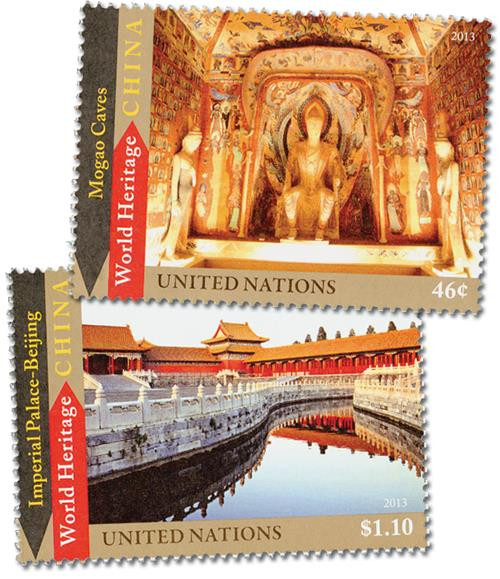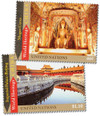
# UN1060-61 - 2013 46c & $1.10 World Heritage Sites in China
2013 U.N. World Heritage – China
New York Office
The 2013 World Heritage stamps honor some of China’s most renowned cultural and natural treasures.
The New York issue features photographs of the Mogao Caves and the Imperial Palace in Beijing. The Mogao Caves, also known as the Caves of the Thousand Buddhas, are made up of 492 cells and cave sanctuaries in China’s Gansu Province. Dating back to 366 A.D., the caves contain nearly 484,376 square feet of murals and over 2,000 painted sculptures depicting evolving cultural scenes composed by Buddhist monks over ten centuries. The Caves were placed on the World Heritage List in 1987.
UNESCO also recognized “The Forbidden City” as a World Heritage Site in 1987. The Imperial Palace in Beijing served as the center of feudal governance for over five centuries under the reign of 24 different emperors. The vast structure covers over 7.5 million square feet and boasts 9,999 and one-half rooms, as well as a 170-foot-wide moat. The Palace is representative of Chinese civilization and hierarchical culture during the Ming and Qing dynasties. Today, it houses the National Palace Museum and exhibits over a million pieces of China’s ancient art treasures.
2013 U.N. World Heritage – China
New York Office
The 2013 World Heritage stamps honor some of China’s most renowned cultural and natural treasures.
The New York issue features photographs of the Mogao Caves and the Imperial Palace in Beijing. The Mogao Caves, also known as the Caves of the Thousand Buddhas, are made up of 492 cells and cave sanctuaries in China’s Gansu Province. Dating back to 366 A.D., the caves contain nearly 484,376 square feet of murals and over 2,000 painted sculptures depicting evolving cultural scenes composed by Buddhist monks over ten centuries. The Caves were placed on the World Heritage List in 1987.
UNESCO also recognized “The Forbidden City” as a World Heritage Site in 1987. The Imperial Palace in Beijing served as the center of feudal governance for over five centuries under the reign of 24 different emperors. The vast structure covers over 7.5 million square feet and boasts 9,999 and one-half rooms, as well as a 170-foot-wide moat. The Palace is representative of Chinese civilization and hierarchical culture during the Ming and Qing dynasties. Today, it houses the National Palace Museum and exhibits over a million pieces of China’s ancient art treasures.








